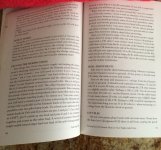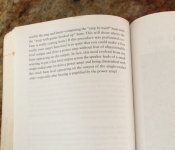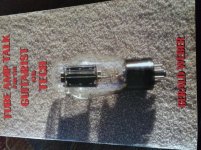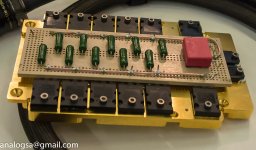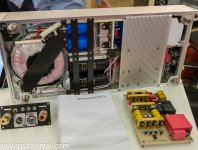So what is it EXACTLY, technically, that makes point-to-point wiring sound better to most musicians than PCBs?? Is it something measureable? Is it just that p-p amps are old while PCB amps are newer?
It's been 24 hours.
I suspect the fact that hand built amps are old and rare makes resellers want to have a reason to make them valuable.
Aside from the obvious difference between overload characteristics of vacuum tubes (gentle odd harmonic filtering) and transistors (hard clip). Many modern "vacuum tube" instrument amps have one 12AX7 which was not the tube that made the nicest distortion when overloaded. the old tube amps are full of 6L6 or 6V6 or something classic.
I own an old ptp Ampeg mono mixer: Transistorized. With new e-caps it sounds fine but I find my 1992? stereo mixer with 4558 ICs on a circuit board was only slightly inferior. But a lot smaller. I used to sit on the Ampex mixer when playing synth. I reworked the RA88a 1992 mixer to sound good with 33078 IC's instead of 4558, which required several circuit mods to bring the faster IC under control. The circuit board and case put the high gain stage next to the AC power switch, which caused some hum - so packaging engineer grade F. Circuit designer grade B. Most mixers and many guitar amps have one or more 4558 in them which is very tame and a bit hissy at high gain.
A newer 1998 Peavey unity mixer has no circuit issues, but the transformer hums mechanically audibly. I think QA standards were higher in 1965 before every product took a dive to the bottom. Electronics ran as a sideshow of the military electronics industry, and during WWII and Korea field testing improved a lot of things like caps, resistors and pots. 1970 later the price became very important, more important than whether it would last twice the warrentee period or not. With prices posted on the internet, people will drive a long life quality vendor to bankrupcy to save 5% in purchase price for "equivalent" products that work great for 6 months past the warrenty.
I suspect the fact that hand built amps are old and rare makes resellers want to have a reason to make them valuable.
Aside from the obvious difference between overload characteristics of vacuum tubes (gentle odd harmonic filtering) and transistors (hard clip). Many modern "vacuum tube" instrument amps have one 12AX7 which was not the tube that made the nicest distortion when overloaded. the old tube amps are full of 6L6 or 6V6 or something classic.
I own an old ptp Ampeg mono mixer: Transistorized. With new e-caps it sounds fine but I find my 1992? stereo mixer with 4558 ICs on a circuit board was only slightly inferior. But a lot smaller. I used to sit on the Ampex mixer when playing synth. I reworked the RA88a 1992 mixer to sound good with 33078 IC's instead of 4558, which required several circuit mods to bring the faster IC under control. The circuit board and case put the high gain stage next to the AC power switch, which caused some hum - so packaging engineer grade F. Circuit designer grade B. Most mixers and many guitar amps have one or more 4558 in them which is very tame and a bit hissy at high gain.
A newer 1998 Peavey unity mixer has no circuit issues, but the transformer hums mechanically audibly. I think QA standards were higher in 1965 before every product took a dive to the bottom. Electronics ran as a sideshow of the military electronics industry, and during WWII and Korea field testing improved a lot of things like caps, resistors and pots. 1970 later the price became very important, more important than whether it would last twice the warrentee period or not. With prices posted on the internet, people will drive a long life quality vendor to bankrupcy to save 5% in purchase price for "equivalent" products that work great for 6 months past the warrenty.
Many single sided PCBs have terrible grounding and layoutSo what is it EXACTLY, technically, that makes point-to-point wiring sound better to most musicians than PCBs?? Is it something measureable?
Too many factors and variables in a build that affects sound that PTP vs PCB is probably low on the list of what makes a product's sound.
PTP can make for smaller loops since its more of a 3-dimension build whereas PCB is flat and all loops are flat and in the same plane.
Most 'PTP' amps are not, they are tag-board with individual wires to here and there. True PTP is each resistor and cap soldered directly on to where they go in the ckt.
Carr, Matchless, and Bad Cat amps are all examples of true PTP.
One could also add PCB materials dialectric, but I think that does not apply at audio frequencies.
The crows nest PTP chaotisity may actually be better than nicely laid out PCB where components are laid out flat and neat in nice parallel and series constructions. PTP is a hell of a time comsuming option tho.
But I really dont think the difference is more than a 'gut feeling' and proper PCB layouts is probably just as good. But nothing beats the charm of a true hand built PTP circuit. My opinion tho.
PTP can make for smaller loops since its more of a 3-dimension build whereas PCB is flat and all loops are flat and in the same plane.
Most 'PTP' amps are not, they are tag-board with individual wires to here and there. True PTP is each resistor and cap soldered directly on to where they go in the ckt.
Carr, Matchless, and Bad Cat amps are all examples of true PTP.
One could also add PCB materials dialectric, but I think that does not apply at audio frequencies.
The crows nest PTP chaotisity may actually be better than nicely laid out PCB where components are laid out flat and neat in nice parallel and series constructions. PTP is a hell of a time comsuming option tho.
But I really dont think the difference is more than a 'gut feeling' and proper PCB layouts is probably just as good. But nothing beats the charm of a true hand built PTP circuit. My opinion tho.
So what is it EXACTLY, technically, that makes point-to-point wiring sound better to most musicians than PCBs?
If schematic and parts are the same, they will sound the same.
If schematics are different, you are comparing apples to oranges.
As a side note, if layout (because that's what you are comparing) makes sound audibly different, then layout is wrong, period ... any of them .
Many single sided PCBs have terrible grounding and layout
Yep, as do plenty of turret board, terminal board, eyelet board, or true PTP ('dead bug') builds.
An externally hosted image should be here but it was not working when we last tested it.
You also have to avoid the trap of: "this amp sounds better and it is point to point wired, so point to point must be what makes it so." And that is not logically valid.
I am not sure there is anything that "most musicians" agree on, but...
Certain amps have been popular and desirable over the years. Some of those were made in the era of point to point construction. it wasn;t the construction that made them sound good, it was the circuit.
I am not sure there is anything that "most musicians" agree on, but...
Certain amps have been popular and desirable over the years. Some of those were made in the era of point to point construction. it wasn;t the construction that made them sound good, it was the circuit.
Many single sided PCBs have terrible grounding and layout
Good PCB layout is a bit of a black art.
One main thing is using star grounding to stop higher power modulations of the ground line reaching lower power parts of the circuit.
I designed a USB mixer and got 1 volt peak to peak hum on the output.
I tracked it down to the power supply injecting the smoothing capacitor charging impulses into the ground line and modulating the audio.
I re-laid out the pcb keeping the power supply completely separate but with one common star ground and the hum was undetectable.
I have designed a few valve amps using pcb's. I always decouple each amplification stage. The ground returns from the output stage is kept separate from the lower power stages to stop noise being fed back to the inputs. Even with AC heaters I get very little noise.
Last edited:
Is it just that p-p amps are old while PCB amps are newer?
I think this is pretty much the answer. There are some legendary amps and what makes them unique is probably less than 5% of it being from PP wiring on tag boards, ground loops and all. If you have a modern amp that is built the same way (sorta) it wont have the original power and OP transformers which is probably 45% of the "sound", any remaining is tubes and operating points. EDIT> and that just the amp electrics much more critical to "the sound" is the speaker and cabs and it's doubtful any original speaker drivers have survived the ages well.
Last edited:
And many old amps had *terrible* wiring and grounding, using iron chassis as ground conductor was common practice, including grounding one end of all filaments so only filament return was through chassis.
Hum/buzz was common, not the exception.
Here's an example:

see grounds taken where available, meaning straight soldering to chassis without much concern, shielded wire also soldered at random.
In fact I remember (born in 1952) that often rather than store bought screened cable, you bought empty naked rolls of "screen" and built your own as needed, including multiple wires if needed.
Popular notg only in Audio but also in RF and TV stuff.
Or screened wire had no outer sleeve, since it was meant to be used inside a chassis anyway and screen was soldered to it where needed:
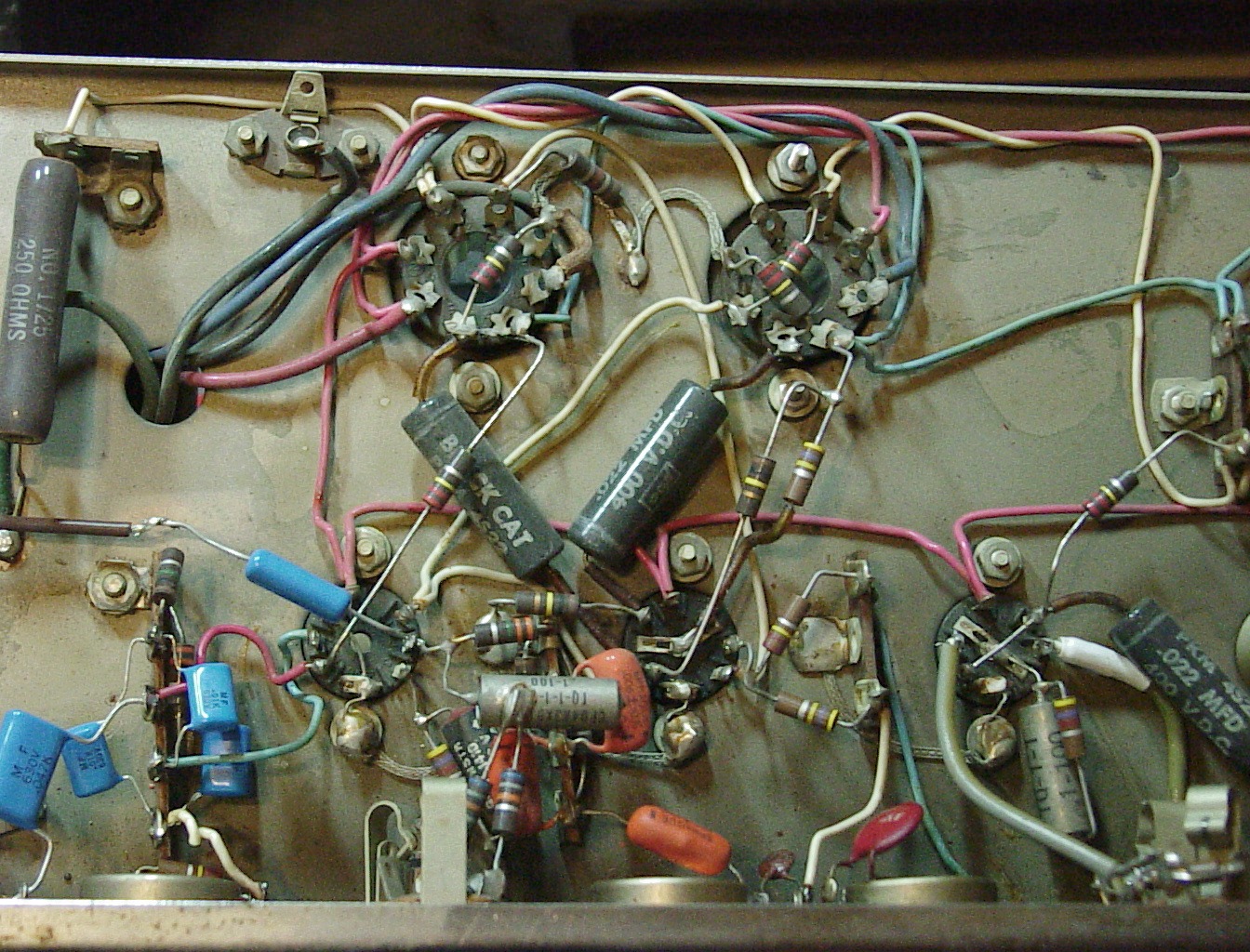
Really, if somebody thinks old "real" PTP wiring was "better" ... should reconsider his thoughts.
I built my first amps in the 60's, using terminal strips, and quickly invested my weekly allowances to buy a bench mounted eyeletting machine , so I was able to make "Fender style eyeletted boards".
In fact I still have it , working like the first day, and still in use eyeletting speaker cones and terminals 😛
, working like the first day, and still in use eyeletting speaker cones and terminals 😛
FWIW in my book Fender style eyeletted boards do not count as PTP by any means, I consider them "no etch PCBs" if you get what I mean.
They:
a) guarantee repeatability, even if built by basic trained workers.
b) can be built independent from available chassis, iron, cabinets, etc. so in slow times you can fruitfully build extra boards and keep them in stock for later orders .
And as a logical step forward, as soon as they could some major Factories, such as Ampeg and Marshall switched to PCBs (we are talking **many** years ago).
Don't think they were fools 😉
Hum/buzz was common, not the exception.
Here's an example:

see grounds taken where available, meaning straight soldering to chassis without much concern, shielded wire also soldered at random.
In fact I remember (born in 1952) that often rather than store bought screened cable, you bought empty naked rolls of "screen" and built your own as needed, including multiple wires if needed.
Popular notg only in Audio but also in RF and TV stuff.
Or screened wire had no outer sleeve, since it was meant to be used inside a chassis anyway and screen was soldered to it where needed:

Really, if somebody thinks old "real" PTP wiring was "better" ... should reconsider his thoughts.
I built my first amps in the 60's, using terminal strips, and quickly invested my weekly allowances to buy a bench mounted eyeletting machine , so I was able to make "Fender style eyeletted boards".
In fact I still have it
 , working like the first day, and still in use eyeletting speaker cones and terminals 😛
, working like the first day, and still in use eyeletting speaker cones and terminals 😛FWIW in my book Fender style eyeletted boards do not count as PTP by any means, I consider them "no etch PCBs" if you get what I mean.
They:
a) guarantee repeatability, even if built by basic trained workers.
b) can be built independent from available chassis, iron, cabinets, etc. so in slow times you can fruitfully build extra boards and keep them in stock for later orders .
And as a logical step forward, as soon as they could some major Factories, such as Ampeg and Marshall switched to PCBs (we are talking **many** years ago).
Don't think they were fools 😉
Many tube sockets had a metal mounting ring with four solder lugs sticking out so you could conveniently ground something to chassis right at the socket. Some are still made that way, but it is not considered good practice nowdays.
Juan, that is a great photo. I love the two 68k resistors at the bottom, soldered to the casing of that cap. And hidden behind that cap is a resistor, you can just see the end if it sticking out above the cap. Love point to point? Try changing that resistor.
Juan, that is a great photo. I love the two 68k resistors at the bottom, soldered to the casing of that cap. And hidden behind that cap is a resistor, you can just see the end if it sticking out above the cap. Love point to point? Try changing that resistor.
From JMFahey: "And many old amps had *terrible* wiring and grounding, using iron chassis as ground conductor was common practice, including grounding one end of all filaments so only filament return was through chassis.
Hum/buzz was common, not the exception."
Very interesting!! Do you perhaps have an example of an "old amp" (Fender?) that had EXCELLENT wiring/grounding usage?
Hum/buzz was common, not the exception."
Very interesting!! Do you perhaps have an example of an "old amp" (Fender?) that had EXCELLENT wiring/grounding usage?
Depends on "excellent." Some of them sound fine and hum is perfectly acceptable. it might be able to get noise down a few more db, but no reason to. Not sure I;d call that excellent, but good enough works in rock and roll.
I have a factory service bulletin from Fender about an old Champ model. Champ has a single ended power stage. The bulletin explains that the single ended stage has no way to cancel B+ ripple hum like a push pull stage can. And since the power stage gets its B+ from the first filter, there will always be a small amount of hum. The bulletin continues telling us not to try to "repair" the hum, as it is not a defect. It is just how that amp is.
I have a factory service bulletin from Fender about an old Champ model. Champ has a single ended power stage. The bulletin explains that the single ended stage has no way to cancel B+ ripple hum like a push pull stage can. And since the power stage gets its B+ from the first filter, there will always be a small amount of hum. The bulletin continues telling us not to try to "repair" the hum, as it is not a defect. It is just how that amp is.
I helped a kid In Saskatchiwan repair an old Sears guitar amp here on I&A. It was PTP wired and a real POS. Everything but filaments was soldered to the steel chassis for ground, willy nilly. he got it working again, which was a wonder, but I imagined it hummed ..At least that one had a B+ transformer, some didn't.
By contrast these Hammond H100 organ amps are wonders of PTP grounding & shielding, separation of low level and high level return paths, local return grounding at each tube grounding ring. The only noise you hear from those when not playing is the motor whirring.
By contrast these Hammond H100 organ amps are wonders of PTP grounding & shielding, separation of low level and high level return paths, local return grounding at each tube grounding ring. The only noise you hear from those when not playing is the motor whirring.
Depends on "excellent." Some of them sound fine and hum is perfectly acceptable. it might be able to get noise down a few more db, but no reason to. Not sure I;d call that excellent, but good enough works in rock and roll.
I have a factory service bulletin from Fender about an old Champ model. Champ has a single ended power stage. The bulletin explains that the single ended stage has no way to cancel B+ ripple hum like a push pull stage can. And since the power stage gets its B+ from the first filter, there will always be a small amount of hum. The bulletin continues telling us not to try to "repair" the hum, as it is not a defect. It is just how that amp is.
Gerald Weber's solution from ' tube amp talk for the guitarist and Tech ' book.
Attachments
I always thought that PC boards were better ,that was the general consensus but now that I've spent more time on the physics of it i think there really is something to using pure cotton insulation and no fiberglass or phenolic in path .sounds crazy i know.
Why pure cotton? Do you prefer unreliable insulation which changes dielectric constant with the weather? The old timers used cotton insulation on wiring because that is all they had; modern plastics hadn't been invented. No reason for us to copy them.
Why pure cotton? Do you prefer unreliable insulation which changes dielectric constant with the weather? The old timers used cotton insulation on wiring because that is all they had; modern plastics hadn't been invented. No reason for us to copy them.
yes ,you are correct using field theory we were taught in school.
the old timers used an ultra pure natural varnish and glypt for humidity - mold control on hv wiring.
I always thought that PC boards were better ,that was the general consensus but now that I've spent more time on the physics of it i think there really is something to using pure cotton insulation and no fiberglass or phenolic in path .sounds crazy i know.
Crazy? Not at all. Let me introduce you to the products of Westminsterlab. Solid state, point to point soldered on perf board, although wire is just plain copper in plastic tubes.
Gold plated copper heat spreader under the outputs, carbon fibre supports under the trafo and caps. Prices vary between 32k and 66k gbp but you already knew that ptp comes at a price 🙂
Attachments
Last edited:
- Status
- Not open for further replies.
- Home
- Live Sound
- Instruments and Amps
- Point-to-point wiring vs. PCBs
